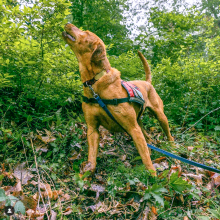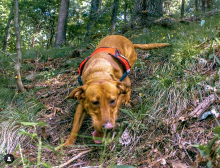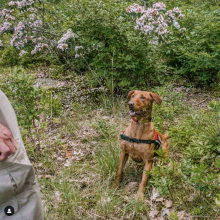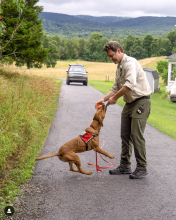
The Dog That Can Save the Forest
Title
Body
Is it possible that the nose of a dog can mean the difference between a healthy forest and a failing ecosystem? The Trail Conference believes so.
Our Conservation Dogs Program—the first of its kind in the Northeast—is already exceeding expectations in its first season. Dia, our Labrador retriever, started her invasives-specific training in November 2018 by learning to detect the presence of Scotch broom (Cytisus scoparius), a species our Invasives Strike Force has been working on removing for years. But young plants can be difficult for humans to find—and finding invasive populations when they are small is critical in eliminating them. Early detection of invasives like Scotch broom is the key to success in protecting our natural areas, making Dia’s nose an important tool.
Conservation dogs can learn to detect up to three new species each year, and we’ve put rookie Dia to the test. In July, Dia learned to detect an invasive grass, slender false brome (Brachypodium sylvaticum), which people have a hard time identifying. This species can outcompete existing vegetation, including threatened and endangered species. Dia quickly learned how to detect slender false brome, and was ready for her next challenge: an insect called spotted lanternfly. A threat to agriculture as well as forests, feeding on more than 70 different plant species, spotted lanternfly is a devastating invasive that is established in eastern Pennsylvania and is quickly spreading to surrounding states. It’s an excellent hitchhiker on vehicles, so Dia has learned to conduct inspections on cars and trucks, as well as field surveys.
Just 2 years old, Dia is making a huge impact on our ability to seek out invasive species and work towards eradication, meaning we can protect our forests more effectively and efficiently. “In three or four years,” Dia’s handler Joshua Beese says, “we’ll be pushing forward the science on what can be done with invasive species detection using dogs.
Dia's Process
- Scents spread out from the source in a cone shape, so Dia starts her search for the target by sniffing the air for one of these scent cones. Scent cone size, shape, and orientation are affected by factors like wind speed and direction, temperature, and humidity, which we take into account when surveying.
- Once Dia works her way into a scent cone, she puts her nose closer to the ground and searches for the exact source of the scent. This step is important when searching for young Scotch broom plants, which can be quite small and low to the ground.
- Once Dia has found the source of the scent, she alerts her handler Josh to her find by sitting.
- Dia celebrates an impressive find with a well-earned game of tug.
Aiding in the Fight Against Invasives
We thank the New York State Department of Environmental Conservation’s Invasive Species Grant Program and the Orentreich Foundation, which have made significant contributions to the Conservation Dogs Program with respective gifts of $100,000 and $50,000. A recent gift of $5,000 from the Laura J. Niles Foundation additionally helps to fund our detection dog team in the Trail Conference’s early-detection efforts. With this support, as well as the gifts of everyone who has contributed to the program, our overall goal of eradicating priority invasive species is possible.



